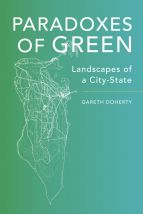Paradoxes of Green: Landscapes of a City-State

Paradoxes of Green is an unusual kind of scholarly book. Conceptually, it brings together urban studies concerns with the young field of design anthropology, which means that Doherty is as comfortable reflecting on the aesthetic aspects of colour as he is describing the ecological implications of property development. The book is structured as a series of vignettes, based loosely around colours. Blue represents the island nation’s relationship with the sea; beige corresponds to the desert landscape.
Methodologically, Doherty embraces his outsider perspective as an Irish academic, based at Harvard, who spent a year in Bahrain living above a hair salon run by a French hairdresser. Paradoxes of Green does not spend time wrestling with statistics or surveys. Rather, it is a more impressionistic account of his experiences walking and talking his way through the small, densely populated, and rapidly growing country, as he explores the tensions around urban development that are coalescing around the colour and concept of “green”.
Doherty suggests that “greenery is at the heart of political struggles over the land of the small city-state” (page 3). This is perhaps clearest when it comes to water. Bahrain has high water consumption, with more than half of the country’s water supply expended on irrigating green spaces. An estimated 63 litres, per capita, are used daily for private green spaces alone.
Of course, the averages obscure the inequities in a highly racially and spatially stratified country, where VIP lanes are intended for the vehicles of royalty, and elite spaces are made inaccessible to pedestrians. The Bahraini elites clearly realize that green spaces are sites of political contestation. Doherty contends that “official unease with groups of unrelated people gathering in public space was one of the reasons for the lack of publicly accessible open space in Manama”, the capital (page 124).
At the same time, “advertising and global positioning have become new infrastructures of green” (page 128). By this Doherty means that business interests are purveying a particular model of attractive urban development – epitomized by golf courses or high-end residential property with lush lawns – that may not be consonant with Bahrain’s environmental realities. Residents retain a strong preference for groundwater over treated sewage effluent, yet a growing population and increasing water demand will increasingly challenge this perception.
Overall, the portrait Doherty paints is of a fascinating, quickly changing, and – yes – paradoxical place.
Further reading:
Kithiia, Justus and Anna Lyth (2011), “Urban wildscapes and green spaces in Mombasa and their potential contribution to climate change adaptation and mitigation”, Environment and Urbanization Vol 23, No 1, pages 251–265, available at http://journals.sagepub.com/doi/pdf/10.1177/0956247810396054.
Rawsthorn, Alice (2010), “The Toxic Side of Being, Literally, Green”, The New York Times, 4 April, available at http://www.nytimes.com/2010/04/05/arts/05iht-design5.html.
Wright, Stephen (2008), Fixing the Kingdom: Political Evolution and Socio-Economic Challenges in Bahrain, available at http://qspace.qu.edu.qa/bitstream/handle/10576/10759/No_3_Fixing_the_Kin....
Book note prepared by Christine Ro
Search the Book notes database
Our Book notes database contains details and summaries of all the publications included in Book notes since 1993 - with details on how to obtain/download.
Use the search form above, or visit the Book notes landing page for more options and latest content.
For a searchable database for papers in Environment and Urbanization, go to http://eau.sagepub.com/

